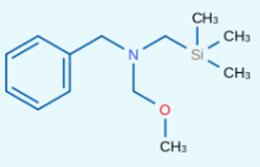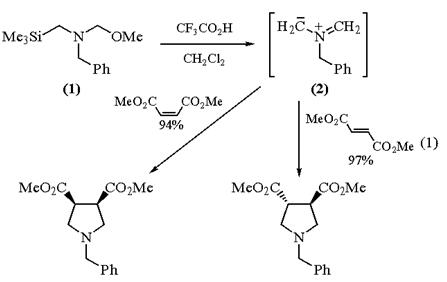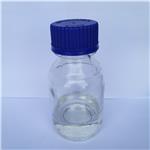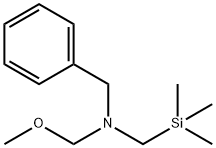Application of N-(Methoxymethyl)-N-(trimethylsilylmethyl)benzylamine

Fig 1. Chemical structure formula of N-(Methoxymethyl)-N-(trimethylsilylmethyl)benzylamine
N-Methoxymethyl-N-(trimethylsilylmethyl)benzylamine forms azomethine ylides which readily undergo[3+2] cycloaddition to α,ß-unsaturated esters affording N-benzyl substituted pyrrolidines in good yields. It reacts with asymmetric 1,3-dipolar cycloadditions in the practical, large-scale synthesis of chiral pyrrolidines. It is used in the the synthesis of 3-carboxy-1-azabicyclo[2.2.1]heptane derivatives, an important class of physiologically active compounds1[1,2].
N-Methoxymethyl-N-(trimethylsilylmethyl)benzylamine is most conveniently prepared by treatment of benzylamine with chloromethyltrimethylsilane followed by formaldehyde and methanol. Access to higher ether homologs is achieved by replacing methanol with the appropriate alcohol. An alternate procedure involves alkylation of lithium N-benzyltrimethylsilymethylamide with methoxymethyl chloride.
N-Benzyl-N-(methoxymethyl)-N-trimethylsilylmethylamine is a valuable reagent for in situ generation of the N-benzyl azomethine ylide. It is generally preferred over alternative silylmethylamine precursors6-8 because of ease of handling and use. The ylide is most conveniently generated from using a catalytic amount of Trifluoroacetic Acid as described by Achiwa. Alternative catalysts include LiF,TBAF, Me3SiOTf-CsF,Me3SiI-CsF. Mechanistic studies provide evidence that the reactive intermediate generated from (1) with either CF3CO2H or F- is a 1,3-dipolar species. Reaction of (2) with alkenes provides an efficient convergent route to pyrrolidine derivatives. Alkynes afford 3-pyrrolines which can be converted into pyrroles. The ylide (2) reacts most readily with electron deficient alkenes and alkynes since this pairing results in a narrow dipole HOMO-dipolarophile LUMO energy gap. Examples of suitable dipolarophiles include unsaturated esters, ketones, imides, nitriles, and sulfones. Cycloaddition occurs with complete cis stereospecificity which is consistent with a concerted mechanism. Dipolarophiles containing an endocyclic double bond afford fused bicyclic pyrrolidines, whereas substrates with an exocyclic double bond provide access to spirocyclic systems.

Styrenes bearing electron withdrawing aromatic substituents such as CN and NO2 give high yields of 3-arylpyrrolidines. When electron withdrawing groups are absent yields tend to be poor. Vinylpyridines afford 3-pyridylpyrrolidines. The reactivity of alkenes can be enhanced by the introduction of a CF3 substituent. For example, a-trifluoromethylstyrene gives a high yield of cycloadduct whereas a-methylstyrene is unreactive[3-6].
In a 2L multi-bottle, add 1282.0g (6,6mol) of benzyltrimethylsilylmethylamine, 800mL (38 lmol) of formaldehyde and 328 mL (38 lmo 1) of methanol, stir at 0℃ for 1 h, and then The temperature was controlled at 10℃~ 15℃ and stirred for 3h. 413.0 g (2.9 mol) of potassium carbonate was added to the mixture, and the mixture was stirred overnight after returning to room temperature, filtered, the filter cake was washed with ether, the filtrate was collected, and the organic phase was separated. The organic phase was concentrated under pressure to obtain 1530.5 g of N-(Methoxymethyl)-N-(trimethylsilylmethyl)benzylamine as a yellow oil with a yield of 91%.
References
[1] A. Stephen K. Hashmi; Dominic Riedel; Matthias Rudolph; Frank Rominger; Thomas Oeser. Regioselective Formation of Saturated Abnormal NHC-Gold(I) Complexes by [3+2] Cycloaddition of Azomethine Ylides and Isonitrile Gold(I) Complexes. Org. Biomol. Chem.2012, 18, 3827-3830.
[2] Ultrasound treatment with LiF in acetonitrile generates an azomethine ylide which undergoes 1,3-dipolar cycloaddition to olefins to give pyrrolidine derivatives in good yield: J. Org. Chem., 52, 235 (1987). Also found use in the the synthesis of 3-carboxy-1-azabicyclo[2.2.1]heptane derivatives, an important class of physiologically active compounds: J. Org. Chem., 66, 2526 (2001).
[3] Terao, Y.; Kotaki, H.; Imai, N.; Achiwa, K. CPB 1985, 33, 896.
[4] Houk, K. N.; Sims, J.; Watts, C. R.; Luskus, L. J. JACS 1973, 95, 7301.
[5] Orlek, B. S.; Wadsworth, H.; Wyman, P.; Hadley, M. S. TL 1991, 32, 1241.
You may like
Lastest Price from N-(Methoxymethyl)-N-(trimethylsilylmethyl)benzylamine manufacturers

US $0.00-0.00/KG2025-07-08
- CAS:
- 93102-05-7
- Min. Order:
- 1KG
- Purity:
- 95.0%
- Supply Ability:
- 10000KGS

US $0.00-0.00/KG2025-04-21
- CAS:
- 93102-05-7
- Min. Order:
- 1KG
- Purity:
- 99%
- Supply Ability:
- 20 mt


